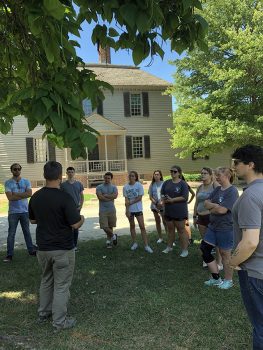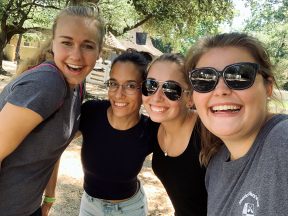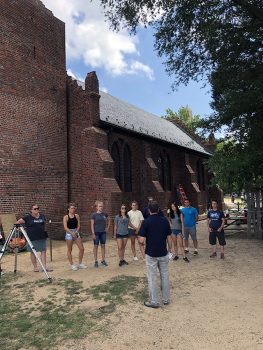Back to Dispatches from Field School
Field School 2019 – Week 7, Part 2
Sofia Aletta – NYU Human Skeletal Biology Graduate Program
“A Field Trip to Virginia”

Mark Kostro (second from left) giving the field school an introduction to the Robert Carter House in Colonial Williamsburg
This week was quite the week! We spent our second week at the Calvert House site, went on a field trip to colonial Williamsburg and Jamestown, and even sailed a replica of a 17th-century tobacco ship!
On Tuesday we woke up bright and early to make our way to Virginia. Once we arrived we toured the labs at Colonial Williamsburg as well as the city itself. During our tour of the labs and artifact collection, we discussed the role that archaeology has in deciphering the social variance within the population of Williamsburg. By interpreting material culture, we can better learn about the social lives of those who came before us. Even still, as the world changes and things become more thoroughly documented and digitized, archaeology remains relevant, just as our history will remain important. We were also fortunate to get a tour of several of the active excavation sites at Colonial Williamsburg. [Editor’s note: many thanks to Kelly Ladd-Kostro for showing us the Colonial Williamsburg lab facilities and Mark Kostro for giving us a tour of the dig sites!]

Happy field school students (including post author Sofia Aletta, second from left) at Colonial Williamsburg
The next day we made our way to Jamestown Island. As a biological anthropologist, I found the trip to Jamestown to be fascinating! David Givens, the Director of Archaeology at Historic Jamestowne, placed emphasis on osteology, the study of bones, and the need for more students to pursue biological anthropology. He described how the bones can speak to analysists to help determine age, sex, and geographic origin of an individual. Most relevant was the case of Jane, a fourteen-year-old woman who was consumed by the other colonists when things got dire in Jamestown. With only a damaged cranium and a partial tibia, forensic anthropologists were able to determine Jane’s sex from various markings on her skull. Most notably, she lacked a pronounced brow ridge, small mastoid processes (an extension off of the temporal bone by the ear canal), and a smooth nuchal crest (a projection at the back of the occipital bone). To determine her age, the anthropologists took X-rays of the mandible, as well as referenced the proximal end of the tibia as the epiphyseal growth plates had not yet fused. Both methods determined that Jane was likely within the early years of development, at about 14 years of age. There were also numerous trauma markings on Jane’s skull indicating cannibalism, as they are in line with the intentional removal of the various muscles of mastication around the cheeks and mouth. As a graduate student in Human Skeletal Biology at NYU, I appreciated the heavy emphasis placed on biological archaeology research at Jamestown and would also like to make my own PSA. Biological and forensic anthropology is an amazing field that gets little attention outside of the fictional world of television shows like CSI and Bones. It is an incredible field that gives a voice to the voiceless, and holds the potential to help inform contemporary cases, as well as the past.
We continued our excavations at the Calvert site, and began preparing for Historic St. Mary’s City’s annual public archaeology event, Tidewater Archaeology Weekend! So, if you or someone you know is at all interested in history, archaeology, or both then come on out to Historic St. Mary’s City on July 20 and 21 and come learn with us!


